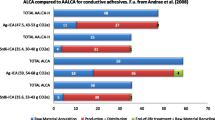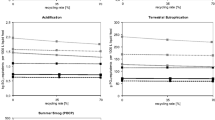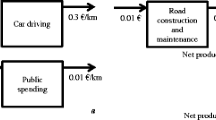Abstract
Goal, Scope and Background
Traditionally, comparative life cycle assessments (LCA) have not considered rebound effects, for instance in case of significant price differences among the compared products. No justifications have been made for this delimitation in scope. This article shows that price differences and the consequent effects of marginal consumer expenditure may influence the conclusions of comparative LCA significantly. We also show that considerations about rebound effects of price differences can be included in LCAs.
Methods
The direct rebound effect of a price difference is marginal consumption. Based on statistical data on private consumption in different income groups (Statistics Denmark 2005a, 2005b), the present article provides an estimate of how an average Danish household will spend an additional 1 DKK for further consumer goods, when the household has gained money from choosing a cheaper product alternative. The approach is to use marginal income changes and the following changes in consumption patterns as an expression for marginal consumption. Secondly, the environmental impact potentials related to this marginal consumption are estimated by the use of environmental impact intensity data from an IO-LCA database (Weidema et al. 2005). Finally, it is discussed whether, and in which ways the conclusions of comparative LCAs can be affected by including the price difference between product alternatives. This is elucidated in a case study of a comparative LCA screening of two different kinds of Danish cheese products (Fricke et al. 2004).
Results
Car purchase and driving, use and maintenance of dwelling, clothing purchase and insurance constitutes the largest percentages of the marginal consumption. In a case study of two cheeses, the including the impact potentials related to the price difference results in significant changes in the total impact potentials. Considering the relatively small price difference of the two products, it is likely also to have a significant influence on the results of comparative LCAs more generally.
Discussion
The influence of marginal consumption in comparative LCAs is relevant to consider in situations with large differences in the price of the product alternatives being compared, and in situations with minor differences in the impact potentials related to the alternatives. However, different uncertainties are linked to determining the pattern for marginal consumption and the environmental impact potential related to this. These are first of all related to the method used, but also include inaccurate data of consumption in households, aggregation and weighting of income groups, aggregation of product groups, estimation and size of the price difference, and the general applicability of the results.
Conclusion
Incorporating marginal consumption in consequential LCAs is possible in practice. In the case study used, including the rebound effects of the price difference has a significant influence on the result of the comparative LCA, as the result for the impact categories acidification and nutrient enrichment changes in favour of the expensive product.
Recommendations and Perspectives
It is recommended that the rebound effects of price differences should be included more frequently in LCAs. In order to ensure this, further research in marginal consumption and investment patterns and IO data for different countries or regions is required. Furthermore, this study does not consider the economic distributional consequences of buying an expensive product instead of a cheaper product (e.g. related to how the profit is spent by those who provided the product). It should also be noted, that more expensive products not necessarily result in less consumption, as those who provided the product also will spend the money they have earned from the sale. Ideally, these consequences should also be further investigated. Likewise, the development of databases to include marginal consumption in PC-tools is needed. In general, considerations of marginal consumption would favour expensive product alternatives, depending, however, on the type of consumer.
Similar content being viewed by others
References
Andersen RD, Brunoe B, Christensen TS, Gregersen TK, Kristensen TG, Thiesen J (2005): Livscyklusvurderinger i et bæredygtighedsperspektiv — Inddragelse af sociale og økonomiske aspekter (Life Cycle Assessments in a Sustainability Perspective — Inclusion of social and economical aspects). Not published. Student report. Aalborg University, Denmark
Binswanger M (2001): Technological progress and sustainable development: What about the rebound effect? Ecological Economics 36, 119–132
European Environment Agency (2005): Household Consumption and the Environment. EEA Report no. 11. EEA, Copenhagen
Ekvall T, Weidema BP (2004): System Boundaries and Input Data in Consequential Life Cycle Inventory Analysis. Int J LCA 9(3) 161–171
Fricke C, Nielsen C, Nielsen AM (2004): Osteklokke eller flowpack? En livscyklusvurdering af Maltheost (Cheese Dish Cover or Flowpack? A Life Cycle Assessment of Malthe Cheese) 2.-0 LCA Consultants, 〈http://www.lcafood.dk/Examples/Malteost.pdf〉 (accessed February 27, 2006)
Goedkoop M, van Halen C, Riele H, Rommens P (1999): Product Service systems: Ecological and Economic Basics, Dutch Ministry of Environment, 〈www.pre.nl/pss/default.htm〉 (October 04, 2005)
Hertwich EG (2005): Consumption and the Rebound Effect: An industrial ecology perspective. Journal of Industrial Ecology 9(1–2) 85–98
Nielsen PH, Nielsen AM, Weidema B, Frederiksen RH, Dalgaard R, Halberg N (2005): LCA Food Database. 〈http://www.lcafood.dk/〉 (accessed February 27, 2006)
Peters G, Hertwich E (2004): Pollution Embodied in Norwegian Consumption. In: Hertwich E, Briceno T, Hofstetter P, Inaba A (2005), Proceedings Sustainable Consumption: The Contribution of Research. NTNU, Program for industriell økologi, rapport nr. 1
Statistics Denmark (2003): Grundmateriale til miljøøkonomisk regnskab for Danmark (NAMEA). Emissionsmatricer og input-output matricer for 1999 (Basic material for environmental economic accountings. Emissions and input-output matrices for 1999). Copenhagen, Statistics Denmark
Statistics Denmark (2005a): Table FU2: Yearly consumption (DKK per household) by type of consumption and income interval and time. 〈http://www.statbank.dk/FU2〉 (accessed October 16, 2005)
Statistics Denmark (2005b): Indkomst, forbrug og priser. Forbrugsundersøgelsen 2001–2003. (Income, consumption and prices. Consumption Research 2001–2003). Statistical News 7, 4–5, 21–22
Thrane M (2006): LCA of Danish Fish Products: New methods and insight. Int J LCA 11(1) 66–74
Tukker A, Huppes G, Guinée J, Heijungs R, Koning A, Oers L, Suh S, Geerken T, Holderbeke M, Jansen B, Nielsen P (2006): Environmental Impacts of Products (EIPRO). Analysis of the life cycle environmental impacts related to the final consumption of the EU-25. IPTS/ESTO project. European Commission, DG Joint Research Centre
Vringer K (2005): Analysis of the Energy Requirement for Household Consumption. PhD dissertation. University of Utrecht, Bilthoven
Weidema B (2003): Market Information in Life Cycle Assessment. Environmental Project 863, Danish Environmental Protection Agency, Danish Ministry of the Environment
Weidema B, Nielsen AM, Christiansen K, Norris G, Notten P, Suh S, Madsen J (2005): Prioritisation within the Integrated Product Policy. Environmental Project 980. Danish Ministry of the Environment
Wenzel H, Hauschild M, Alting L (1997): Environmental Assessment of Products. Volume 1: Methodology, tools and case studies in product development. Chapman & Hall, London
Author information
Authors and Affiliations
Corresponding author
Additional information
ESS-Submission Editor: Dr. David Hunkeler (david.hunkeler@aquaplustech.ch)
Rights and permissions
About this article
Cite this article
Thiesen, J., Christensen, T.S., Kristensen, T.G. et al. Rebound effects of price differences. Int J Life Cycle Assess 13, 104–114 (2008). https://doi.org/10.1065/lca2006.12.297
Received:
Accepted:
Published:
Issue Date:
DOI: https://doi.org/10.1065/lca2006.12.297




